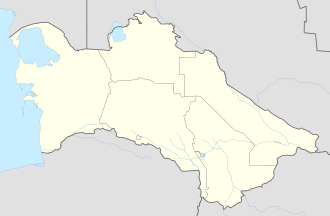Ymamnazar Cyrillic Ымамназар Imamnazar | |
|---|---|
| Coordinates: 37°14′56″N65°15′47″E / 37.24889°N 65.26306°E | |
| Country | |
| Province | Lebap Province |
| District | Kerki District |
| Time zone | UTC+5 (TMT) |
Ymamnazar (also Ymam Nazar, Imamnazar) is a remote settlement in Turkmenistan's Lebap province. It is situated immediately adjacent to Turkmenistan's southern border with Afghanistan, opposite to Aqina. The nearest city in Turkmenistan is Kerki.
Contents
In 2007, an international border crossing point was opened in Ymamnazar, [1] making it one of two international border crossings on the Turkmenistan-Afghanistan border, the other being Serhetabat-Torghundi. The border crossing is officially called "Saparmurat", after Saparmurat "Turkmenbashy" Niyazov, the first president of Turkmenistan.
There are basic transshipment facilities here, including a small oil terminal [2] for shipping Turkmen hydrocarbons onward into Afghanistan.

